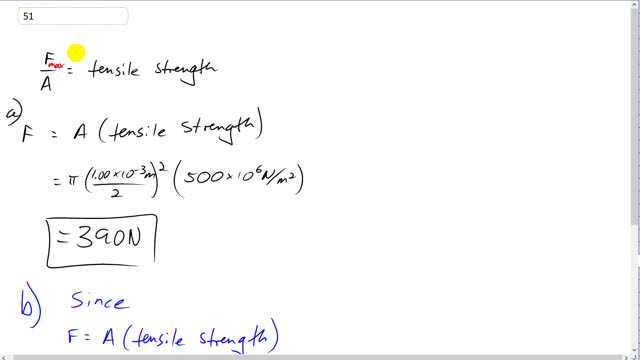
- What is the maximum tension possible in a 1.00-mm-diameter nylon tennis racket string?
- If you want tighter strings, what do you do to prevent breakage: use thinner or thicker strings? Why? What causes strings to break when they are hit by the ball?
- Use thicker strings

In order to watch this solution you need to have a subscription.
This is Giancoli Answers with Mr. Dychko. The tension force divided by the cross-sectional area of the material equals its tensile strength; this is for the maximum force. Now when you multiply both sides by A, you get that the maximum force is area times the tensile strength. So we have π times the radius squared which is diameter expressed in meters as 1.00 times 10 to the minus 3 meters divided by 2 and then square that resulting radius times 500 times 10 to the 6 newtons per square meter which is the tensile strength of nylon and that gives 390 newtons. I could have put, you know, maybe three significant figures in this answer but I chose only two and could even do one because this tensile strength is just a ballpark number and it could very considerably depending on the actual specimen of nylon that you have like if the nylon has some nicks in it because maybe it's been used for a while then it will actually be a lot weaker. So next part is to say that if you want to increase the tension in the strings, you should increase the area since the maximum force is proportional to the area so as area increases then force does as well. So if you multiply area by 2, you would multiply the maximum force by 2 so you should use thicker strings that have a bigger area. And strings eventually break when a hard hit occurs with the tennis racket because the collision causes the tension in the strings to increase and the strings will break if the tension exceeds this maximum tension here.